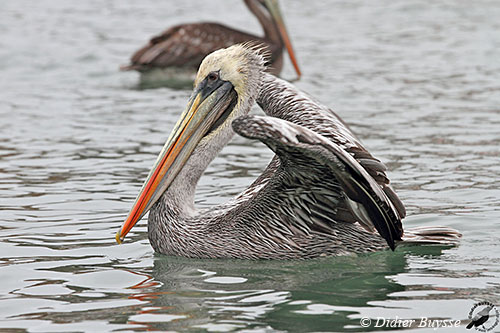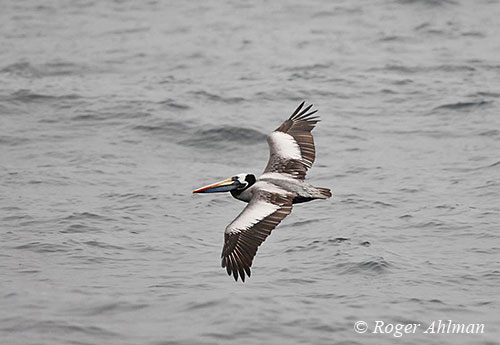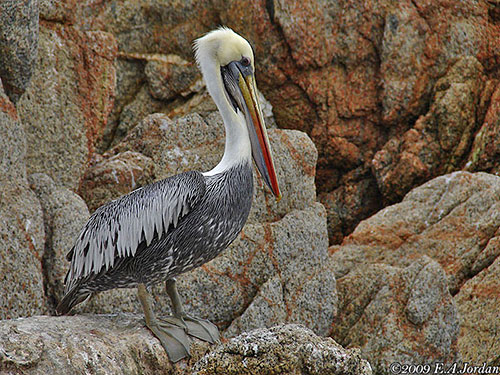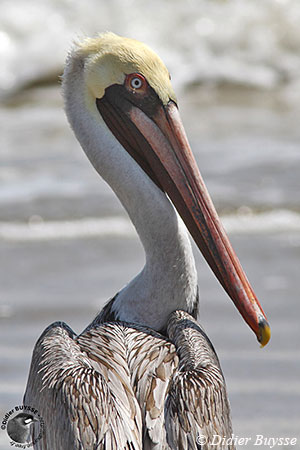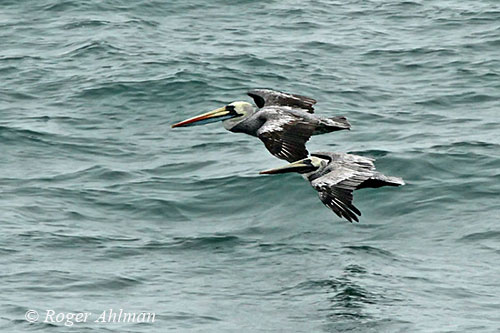
Fr: Pélican thage
Ang: Peruvian Pelican
All: Chilepelikan
Esp: Pelícano Alcatraz - Argentine: Pelícano pardo
Ita: Pellicano del Perù
Nd: Peruaanse Pelikaan
Sd: perupelikan
Photographers:
Roger Ahlman
Pbase Galleries Peru and Ecuador
John Anderson
John Anderson Photo Galleries
Didier Buysse
Vision d’Oiseaux
Eduardo Andrés Jordan
MIS AVES – AVES DE ARGENTINA
William Price
PBase-tereksandpiper & Flickr William Price
Dubi Shapiro
Dubi Shapiro Photo Galleries
Simon Tan
PBase Bird galleries
Alan & Ann Tate
AA Bird Photography
Text by Nicole Bouglouan
Sources:
HANDBOOK OF THE BIRDS OF THE WORLD vol 1 by Josep del Hoyo-Andrew Elliot-Jordi Sargatal - Lynx Edicions - ISBN: 8487334105
Arthur Grosset's Birds (Arthur Grosset)
Primer registro de anidación del Pelícano Peruano Pelecanus thagus (Pelecaniformes: Pelecanidae) en Ecuador
How the Peruvian Pelican Reflects Changes in the Environment
Wikipedia, the free encyclopaedia
Wikipedia, la enciclopedia libre
Peruvian Pelican
Pelecanus thagus
Pelecaniformes Order – Pelecanidae Family
INTRODUCTION:
The Peruvian Pelican is found on the west coast of South America, along the coasts of Peru and Chile in the Humboldt’s Current area of which it is endemic.
It was formerly a subspecies of the Brown Pelican, but it is now a full species. It is twice as large and has brighter bare parts during the breeding season.

Peruvian Pelican and
Brown Pelican (on the right)
The Peruvian Pelican is strictly marine and can be seen along the coasts, in bays and estuaries, but it usually avoids the open sea. The breeding sites are on rocky coasts and remote islands to avoid the predators. It breeds in loose colonies, forming groups of different sizes. Both parents share the nesting duties.
It feeds mainly on fish, especially anchovies.
The Peruvian Pelican is affected by El Niño events, involving desertion of the breeding grounds and mortality of eggs and chicks.
The overfishing of anchovies reduces the prey availability, but today, the breeding islands are protected and the population appears to be stable or increasing. However, the Peruvian Pelican is currently classified as Near Threatened.
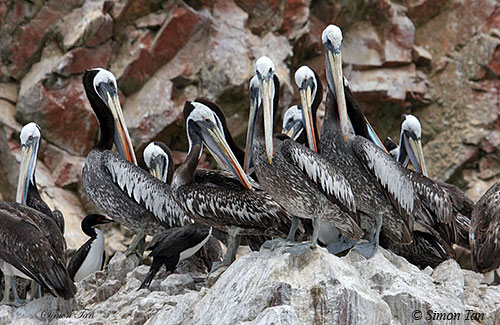
DESCRIPTION OF THE BIRD:
Biometrics:
Length: 137-152 cm
Wingspan: 228 cm
Weight: 5-7 kg
During the breeding season, the Peruvian Pelican has dark body plumage with varying shades of grey. On the upperwing, scapulars and tertial coverts are pale silvery-white, whereas median and most of lesser upperwing coverts are pale silvery-grey. This pattern forms a large, pale panel conspicuous in flight and contrasts with the dark flight-feathers. The tail is relatively short and rounded, with a colour similar to the body plumage.
On the underparts, the belly is slightly darker than flanks and body sides. The feathers show narrow, whitish shafts and some pale spots, giving a streaked pattern.
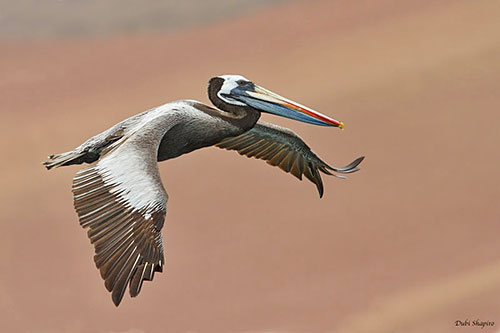
On the head, the pale yellowish-white nuchal crest is longer at the beginning of the breeding season. The facial skin is blackish and warty around the bill base to the front of the eye, and down to chin and throat. We can see a whitish stripe extending from the top of the bill up to the head and down to the neck sides. Chin and throat are black. Forehead, crown and ear-coverts are yellowish-white with pale rufous tinge above the eyes and around the bill base. The neck is black on the rear side, from nape to upper mantle.
The long, whitish-horn bill is brightly coloured, with red tip and pale blue gular pouch, and with some black and cream-yellow at base. We can see a small, yellow hook at tip.
The eyes are pale blue-grey.
Legs and webbed feet are olive-green to dull yellowish.
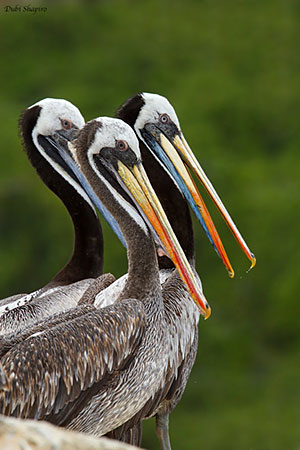
The Peruvian Pelican in non-breeding plumage has shorter nuchal crest and entirely white neck, but chin and upper throat are black. The bill is slightly duller, like the plumage overall.
Male and female are similar.
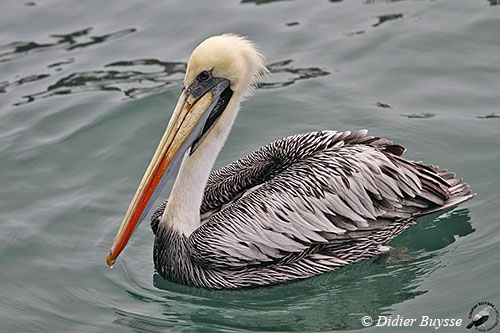
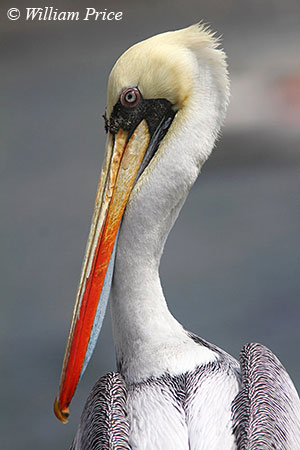
The juvenile has dark brown plumage, including neck and rear of the head. The underparts are whitish with brown streaks on flanks and body sides.
Forehead, forecrown and ear-coverts are dull white. Bill and gular pouch are much duller than in adults, mostly pale yellowish and whitish. The eyes are dark brown. The legs are yellowish to greyish.
It acquires the adult plumage at the age of two.
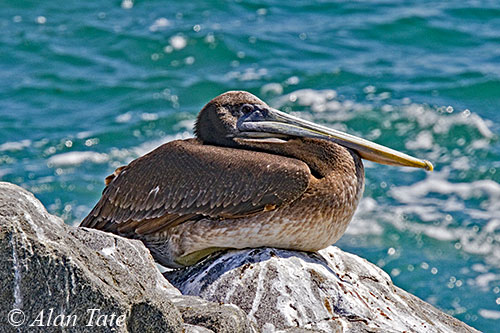
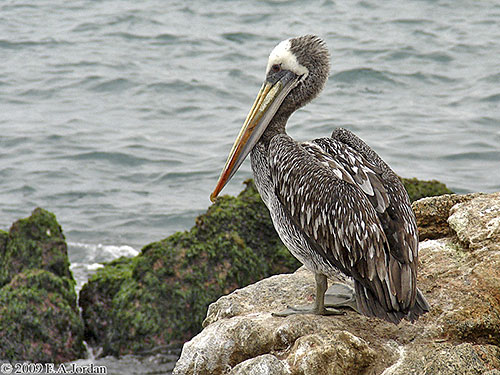
RANGE:
The Peruvian Pelican is found on the west coast of South America, from S Ecuador and Peru, S to S Chile, and very occasionally to Tierra del Fuego.
The species breeds on the coasts, from Lobos de Tierra Island in N Peru, to Pupuya Islet in C Chile.
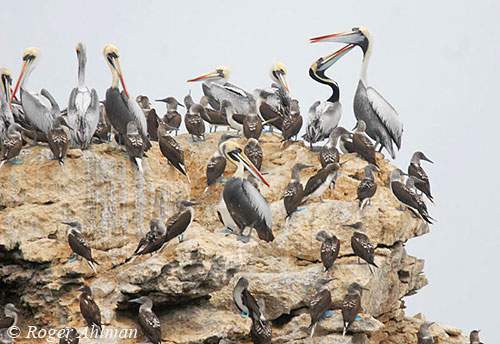
HABITAT:
The Peruvian Pelican breeds in large colonies on arid rocky coasts and remote small flat, bare islands.
It is also seen around fishing ports where it feeds on fish scraps. It also roosts on fishing boats.
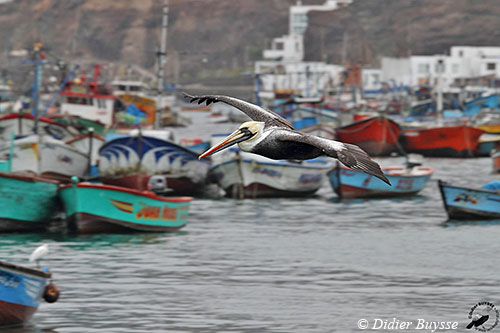
CALLS AND SONGS: SOUNDS BY XENO-CANTO
The adults are usually silent away from the breeding colonies. The Pelecanidae have no syringeal muscles and are unable to produce vocal sounds.
The Peruvian Pelican produces hissing sounds, and bill-clapping is also heard. These noises may be associated with courtship displays and interactions between individuals
The young birds utter some groans, yelps, screams, chattering, barking and grunting when they are hungry.
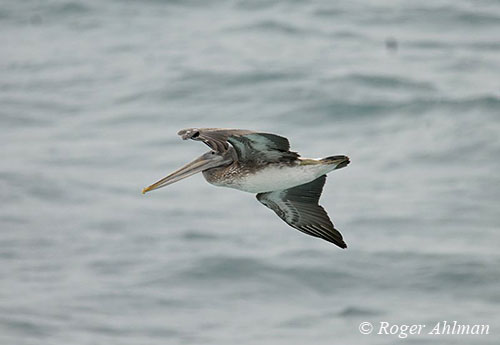
BEHAVIOUR IN THE WILD:
The Peruvian Pelican feeds almost exclusively on the Peruvian anchovy (Engraulis ringens) of the Humboldt’s Current, making it very vulnerable to the phenomenon El Niño which can change the current.
It feeds by diving into shallow waters, but it may occasionally steal food from other bird species. The prey ends up in the gular pouch used as fishing net. This pouch is very flexible and can hold a great quantity of water. Once the prey is caught, the bird purges the water and swallows the fish whole. But it also takes prey by swimming on the water.
It may occasionally take other food items such as nestlings of the Imperial Shag, young Peruvian diving-petrel and Grey Gull. It also takes advantage of scraps of fish discarded by fishermen.
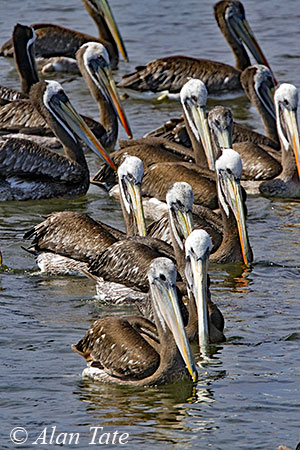
The Peruvian Pelican breeds in loose colonies established on coasts and islands. It often breeds near other bird species including the Brown Pelican, the Magnificent Frigatebird and the Blue-footed Booby.
This observation was made in Ecuador, on Santa Clara Island in the Gulf of Guayaquil, El Oro Province. There were 24 nests close to each other, occupying an area of only 12 m².
This colony was 300 metres apart from the colony of the Brown Pelican, and about 500 metres from the two other species. The birds were calm and no interaction between them was observed.
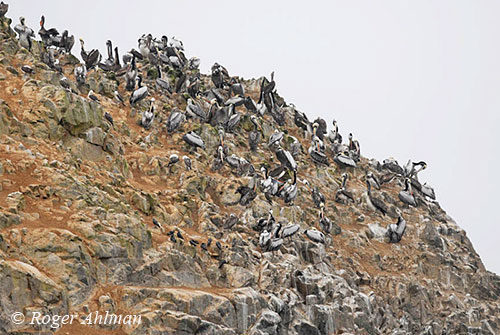
The courtship displays are not described, but the closely related male Brown Pelican often perches on a branch and starts to display by “Head-swaying” and the female is quickly attracted. During this display, the white nuchal crest is probably exposed. No further behaviour is observed to confirm the pair-bond. It seems probable that a new pair forms each year. Settlement and courtship begin in mid-September/October.
The Peruvian Pelican nests on the ground in a hollow scrape in sand or guano. Both parents care for the chicks for up to three months and feed them by regurgitation.
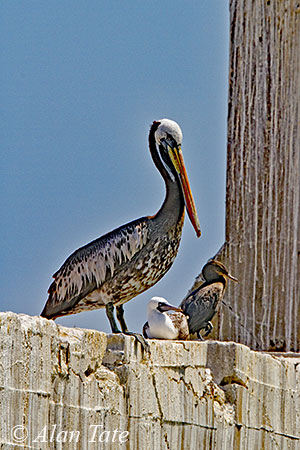
Most populations of the Peruvian Pelican are resident or dispersive. The species may move if the food availability is reduced by El Niño phenomenon.
It is a visitor in Southern Chile and Ecuador.
The Peruvian Pelican is a powerful, large, heavy bird, and to take off from the water requires a great effort. It needs to run over the water with strong wingbeats, while pounding the surface with the large webbed feet. It can be observed from the shore as it flies back and forth in coastal waters with steady flaps interspersed with glides. It flies close to the sea-surface or at medium-height, usually in V formation.
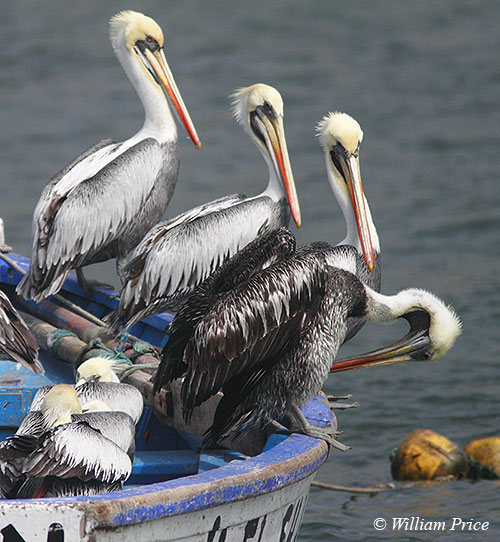
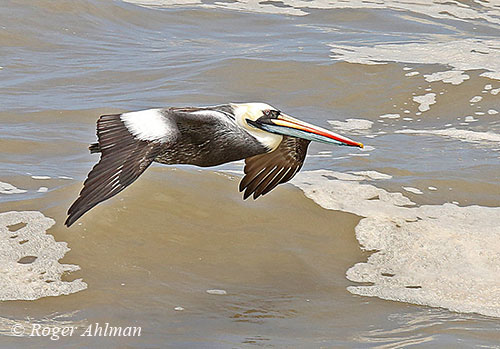
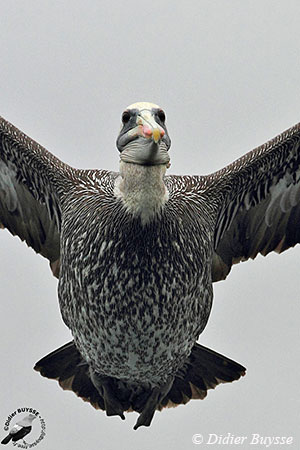
When fishing, it dives from the air at shallow depths to catch a prey. When the bird hits the water very hard, the muscles around the neck stiffen to protect the spine. The straight-back wings defend against the waves, and the air sacs placed under the neck skin act like an airbag before the bird meets the water. It is true that one wrong move can result in broken bones or death.
The Peruvian Pelican alights with the webbed feet held forwards when touching the water.
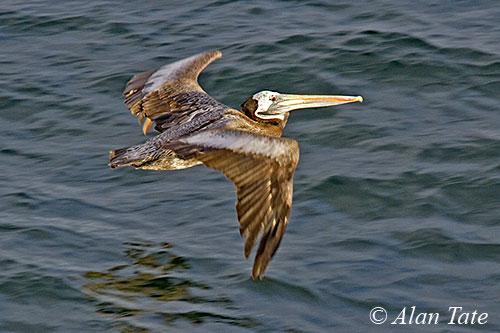
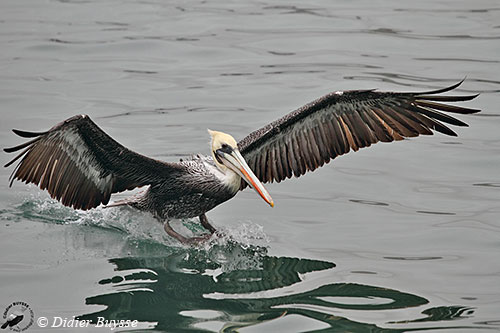
REPRODUCTION OF THIS SPECIES:
The breeding season takes place in September through March, during the austral spring/summer. However, it can occur throughout the year, and some observations of winter breeding have been reported.
The Peruvian Pelican breeds in colonies established on rocky shores and remote offshore islands. The nest is a hollow scrape of just 25 cm in diameter, on sand or guano.
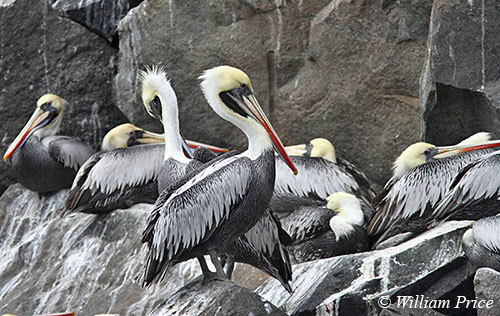
The female lays 2-3 whitish eggs of about 150 grams. They are laid at intervals of 48 hours. The hatching occurs about five weeks later. The chicks are fed by both parents by regurgitation into the chick’s mouth. The young birds depend on adults during up to three months. The chicks gather in crèches at 3-4 weeks old. They fledge 85 days after hatching.
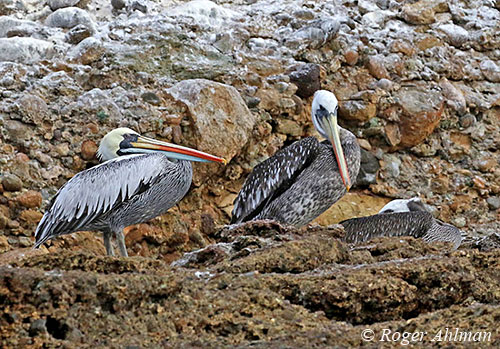
PROTECTION / THREATS / STATUS:
The Peruvian Pelican is affected by predation by Turkey Vulture and gulls (Family Laridae) during the breeding season, when eggs and chicks are taken by these avian predators.
The species is also affected by El Niño events, involving desertion of the breeding grounds and a significant mortality of eggs and chicks. The birds perform extensive southward movements in search of food and better environmental conditions.
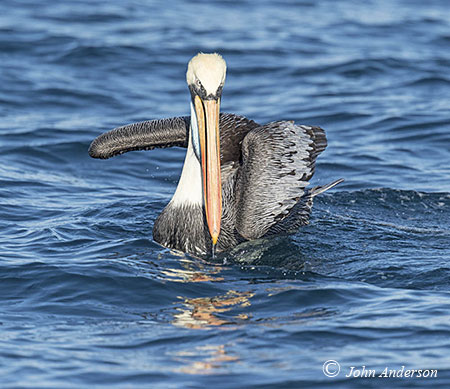
The overfishing of anchovies reduces the prey availability, but today, the breeding islands are protected and the population appears to be stable or increasing. But the declines caused by El Niño events could be occur again in the future.
The size of the population is placed in the band 100,000/1,000,000 individuals.
For these reasons, the Peruvian Pelican is currently classified as Near Threatened.
